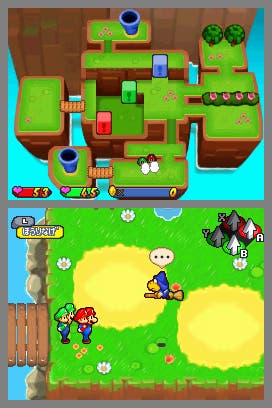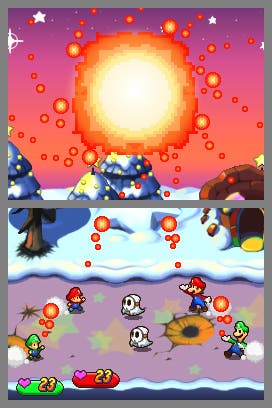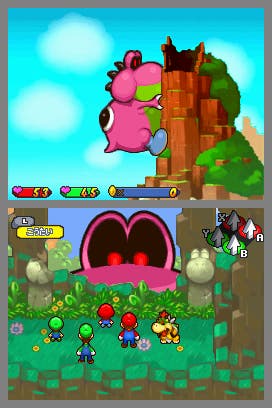Mario & Luigi: Partners In Time
I HAVE LOVE!
Yes it is.
That's all anyone wants to know.
It is every bit as good as Superstar Saga, and it is worth buying immediately. The next eighteen million words will be spent reassuring you of these truths.
If you have, as I once did, come late to the world of Mario's RPG adventures, you'll probably feel that sense of frustrating outsider-i-ness when you see intros like that. I remember when Mario & Luigi: Superstar Saga came out two years ago, and everyone was explaining how it was a sequel to Super Mario RPG, and how it had never been released in the UK, and how wonderful it was and why you were bad for never having even heard of it, let alone played it nineteen times through. And I thought, hmmph, well then, this game won't be for me.
I can't remember why, but I bought it and played it anyway. Perhaps it was a desire to defy those smug insiders. And 34 hours and 36 minutes of game time later, I was one of them. You'll understand when the next one comes out, because by then you'll be all caught up and in on the deal.
It's going to be impossible to review Partners In Time without making referrals to its predecessor, and I'm genuinely sorry if you've not played it. But here's the thing - if you've got a DS, you've the capability to play Superstar Saga; and please, look at my eyes, I'm telling you the truth: you will love me for being the person who convinced you to check it out.

Partners In Time once again, er, partners up Mario and Luigi and sets them off on an adventure to... guess what? Rescue Princess Peach! And once again, while perennial enemy Bowser is around and causing trouble, he's not the primary source of the mischief. This time a race of purple alien mushroom creatures called Shroobs have captured the pink princess and taken her... back in time.
Thus the premise is set for the plumbing brothers to embark upon another royalty rescuing ramble, exploring the platform-and-RPG hybrid worlds in both the present day and in the past. And it's this time travel that brings in PiT's new characters, Baby Mario and Baby Luigi. Apparently not hindered by the paradox-creating difficulties of encountering your own past self, the Mario Bros team up with the Baby Mario Bros, putting you in control of all four at once.
As succinctly as possible, Mario & Luigi: Partners In Time is the mutant child of an RPG and a platform game, a character-driven story explored by jumping on creatures' heads and hitting them with hammers. Winning fights gains XP, which levels the cast, giving them the abilities to fight the more powerful enemies. Which is all an elaborate, deeply refined and involved means of reaching the next toadstool to chat with, or mad exchange with a mad professor.
When Superstar was first encountered, it seemed far too fiddly to be able to control two characters in tandem. But somehow this was immediately not a problem, and as the game progressed, many abilities were given to each. Mysteriously, you were managing to work them both independently and in cooperation, your fingers dancing over the buttons with the nonchalant ease of a touch typist. This time you've been given four to manage at any one time, and once again, you're certain this is going to be impossible.
Alphadream are geniuses. Given the DS, they did not look at the touch screen and attempt to work out how to crowbar an alien input device into their world. Instead, much as with Superstar, they looked at the pattern of buttons on offer, and designed a game around the machine's structure. Four buttons on the right, A, B, X and Y, so assign one to each character. Movement is as simple as pressing the D-pad, with all four following Mario's lead, the Babies riding piggyback on their, um, own shoulders.

Making it even more interesting, the Babies can be thrown off, and then run off on their own, splitting your party into two teams and hence offering many scenery-based puzzles. As your skills develop, the Babies can be flattened to discs (wow, that sounds bad out of context) and slotted into narrow gaps, or Mario and Luigi's spinning move can send the kids flying off into the otherwise unreachable distance (amongst many more combinations). The game gives you a series of tools, and then asks you to implement them. The touch-screen is, but for one extremely peculiar and entirely pointless moment, ignored. And oddly enough, that's just as it should be.
What's interesting is quite how different a game Partners In Time actually is, when laid alongside its older brother. Superstar was a deconstruction of the Mario universe, a parody of all that had gone before, and a cunning grin at the conventions it was at once mocking for their over-use, and seamlessly using to perfection. For instance, Mario jumps up and headbutts floating blocks. Something we've always just accepted, which is really rather strange of us. Superstar Saga took the brothers to a museum where blocks from their previous games were on display, and out back a laboratory where blocks for future Mario games were being developed. A running joke was how unfamiliar Luigi was to so many players, with game characters, to Luigi's dismay, all unable to remember his name. "Hooray! It's Mario! And the, er... green guy." It was the meta-Mario, frame-breaking and delightfully silly. Partners In Time, very surprisingly, doesn't even venture near this topic.
This is a game about the personalities of the brothers. It's their character that drives the story, rather than the plot, which is, of course, extremely thin. They're once again just chasing down parts of a missing and fragmented star, in an attempt to recover their oft-captured friend. But rather than being tired or repetitive, here it is the expected foundation on which more interesting insights can be built.
Seeing their infant selves reveals a great deal of their internal drives. Baby Mario, armed with a hammer, cannot help but try to rescue. While the rest are discussing a predicament, perhaps someone trapped in a cage, Baby M will run off on his own and tirelessly, but uselessly, smash away at the walls. When stopped by an adult, he sits and cries. Mario has been driven to rescue since birth.
This may sound like so much bullshit, overly reading into a cartoonish and deeply daft game. But upon completion, there's no doubt that something more mature is going on. Here Luigi is not mocked for being unknown, but for being a coward. In fact, in one particularly striking moment, a character looks into his heart and condemns him for his selfish cowardice in a shocking fashion. There's something deeper going on, the hammer-blow of the tragedy when people notice that Baby Luigi shows no such behaviour. Something happened to Luigi. Man.

Of course, for the most part Partners In Time is hilarious, light-hearted nonsense. I can't think of another game that has had me running into my housemate's room and making him read the screen, while shaking with laughter, over and over.
If you played Superstar then you'll remember Fawful, the main baddie's assistant who so brilliantly spoke in badly translated Japanese game-speak. It was the ultimate in-joke, and tears of laughter were shed. "I HAVE FURY!" This time around there's Stuffwell, a suitcase that accompanies the quad of brothers, storing all their power-ups and special items, as well as acting as a spokesperson when other characters are encountered. He is, by far and away, the very cutest thing ever in the whole history of the entire world, ever. A million billion cute. And he speaks in badly translated Japanese instruction-manual English. I could die of happiness.
"Rudimental!" he cries. "What fortulent timing! Press B to initiate my closing minification cycle and store me..." Always followed by my new "I HAVE FURY!"-replacing catchphrase, "BACK TO ADVENTURE!"
This excellent, knowing, and perfect writing exists throughout the nearly 30 hours of the game. (27 hours 17 minutes, actually). All these lines are from early moments to avoid deep spoilers, so just by way of another proving example, here's one more line I had to jot down when uttered by baddies encountered near the beginning:
"AREA RESTRICTED. ALL NOOB INTRUDERS 2 B HAXORED BY US L33T HAMM3R BROZ.!"
Later they celebrate with, "W00t W00t W00t W00t W00t!"
Oh, go on, one more, please. Uttered by a little Toad in Peach's home:
"This castle's so big, I sometimes get lost. And then I cry a little."

Do you see what I'm doing here? I'm not spending ages describing the gamplayosity, or the high graphicsability. I'm trying to capture something of the experience of what it's like to play this game. It's emotional, ridiculous, and joyous. In fact, how to control it is a part of playing it - the game wants to teach you. Naming all the special moves, or explaining how one engineers the most efficient use of the Pocket Chomps or Smash Eggs - they would be horrific spoilers.
A quick explanation of combat is necessary. As with Superstar, and indeed the GameCube's Paper Mario: The Thousand-Year Door, fights are turn-based, and exist as a learning process. The first time an enemy is encountered, fighting it may be remarkably tricky. Weak-spots are discovered, ideal Bros Items are found by experimentation, and the best way to take advantage of the special move Bros Attacks are exposed. Soon when you meet them you'll polish them off without a worry. The way an enemy attacks you is equally learned. Subtle hints are given before attacks are made - a wink of an eye, the flick of a tentacle - and appropriate counter-attacks can be executed. In some sense, every enemy behaves like a well-made boss - they have weaknesses to be exploited, changing from impossibly strong to easily defeated, without having their difficulty artificially hiked to contradict your developing skill.
Talking of well-made bosses, oh my goodness. Nintendo are endlessly guilty of annoyingly hard bosses, vastly out of proportion with the rest of the game, becoming a hateful frustration that sits between you and any further possible enjoyment. Of the perhaps dozen bosses in Partners In Time, not a single one offends. In fact, they're enormous fun. They're tough. They might even cause a game over. But they are exploitable and defeatable. Superstar was perhaps a teensy bit naughty with its final bad, but no such crime appears here. The final wave of bosses are fantastic, extremely detailed and multi-layered, one taking maybe fifteen minutes to defeat. But I got each one first time. Not because it's stupidly easy, but because it's wonderfully playable. The sense of relief that the fight is over is still huge. But the DS was never thrown across the room, and I didn't have to make the Babies blush with bad language.
A refined version of the previous engine looks utterly lovely. It's simple, but it's very, very pretty, and the character details are gorgeous. Scripted moments inevitably feature one of the two Babies getting upset and crying, which is funny each and every time. Luigi's terror at realising he can't cheer his child self always made me laugh out loud, and it didn't matter how many times he fainted, every time it produced a chuckle.

The top screen is used in two ways. Most of the time it acts as a general map, showing you whereabouts the Brothers are in that particular zone. Because the game has a much more level-based structure than Superstar's exploratory open world, the map gives a helpful indication of progress, and acts as a hint mechanism for where perhaps a bonus route should be hunted out. Then, when the Babies find one of the myriad areas too small for Mario and Luigi to enter, they appear up on the upper screen, letting you move each pair around at once. Again, this gives rise to lots of involving environment challenges.
Oh, and the sound. The sound! The music is stupendous, making clever references to classic Mario tunes, remixing them with the DS's more sophisticated abilities. Remember that excellent ominous ditty that you heard when going down pipes in Super Mario? Now imagine it with a developing primal beat, and the strain of strings in the background. Then there's the faithful noises of jumping, hitting and being hit, just as they should be. And best of all, the hysterical pseudo-Italian babble when Mario and Luigi chat. Occasionally words of English come from their mouths, which you'll find yourself chanting afterward. "BABIES!" "THANKYOUVERYMUCH!" So fun.
There's one other thing I'm dying to tell you. But I can't. If I did, I'd rob you of the moment when I threw both arms above my head (DS on the desk) and clapped, while shouting, "WOOOOOO-HOOOOOOOOO!" very loudly. And I can't do that to you. So instead, please, whatever you do, don't forget to EXPLORE VERY CAREFULLY IN THE BASEMENT OF THE CASTLE.
It's gorgeous. It's cute. It's surprisingly deep. It's deeply satisfying. And it's oh so hilariously funny. So is there a weakness? A tiny one. While I obviously hate to disagree with anyone, especially Tom, I'd have given Superstar Saga a 10. Partners In Time gets a 9. And the reason for that is that the level-based design has led to a tendency for repetition. While enemies can be avoided, it doesn't change the fact that in about three of the zones their second half is an awful lot like their first half, but without all the new characters to meet. Fantastically, this isn't a problem for the second half of the game, but it does cause the occasional grimace for the first chunk. Occasional, mind. And never long-lasting.
Twenty-seven hours. Without getting stuck. It's HUGE. It's like getting the most wonderful box of chocolates, and then finding that there's a second layer of them underneath the first tray. And then a third. And a fourth. I didn't mention this until now, but it's unquestionably the best DS game so far. And I suspect it will be the best for a long time to come.
BACK TO ADVENTURE!








